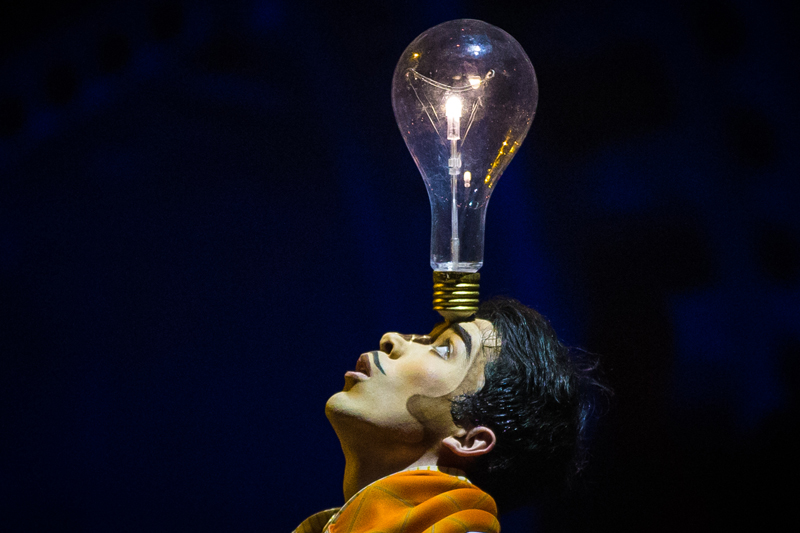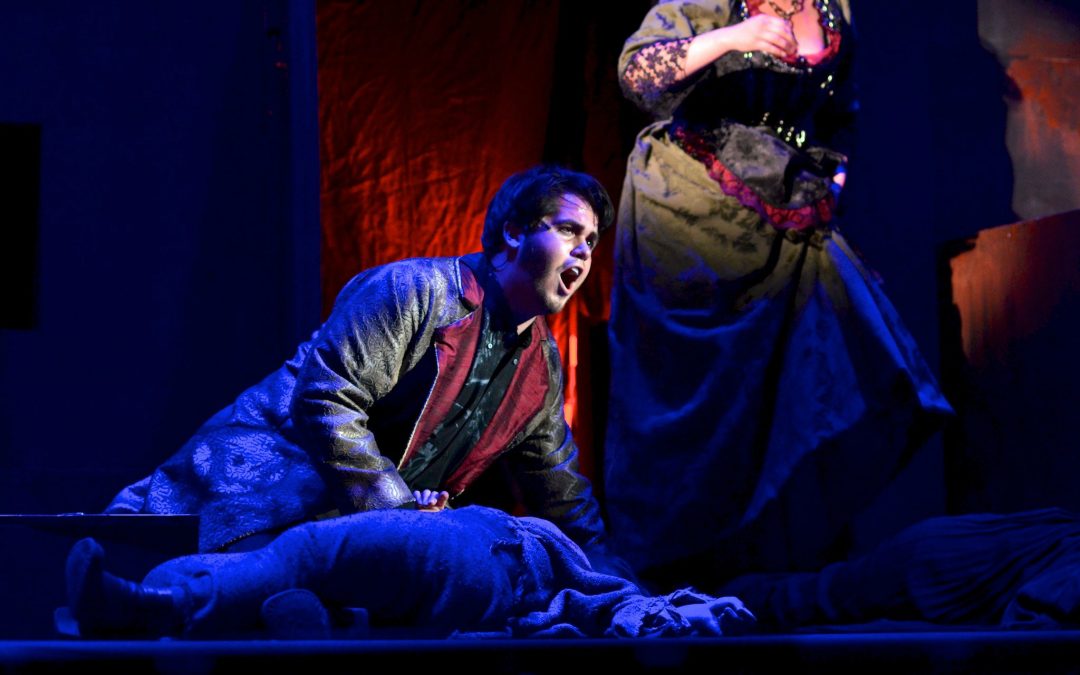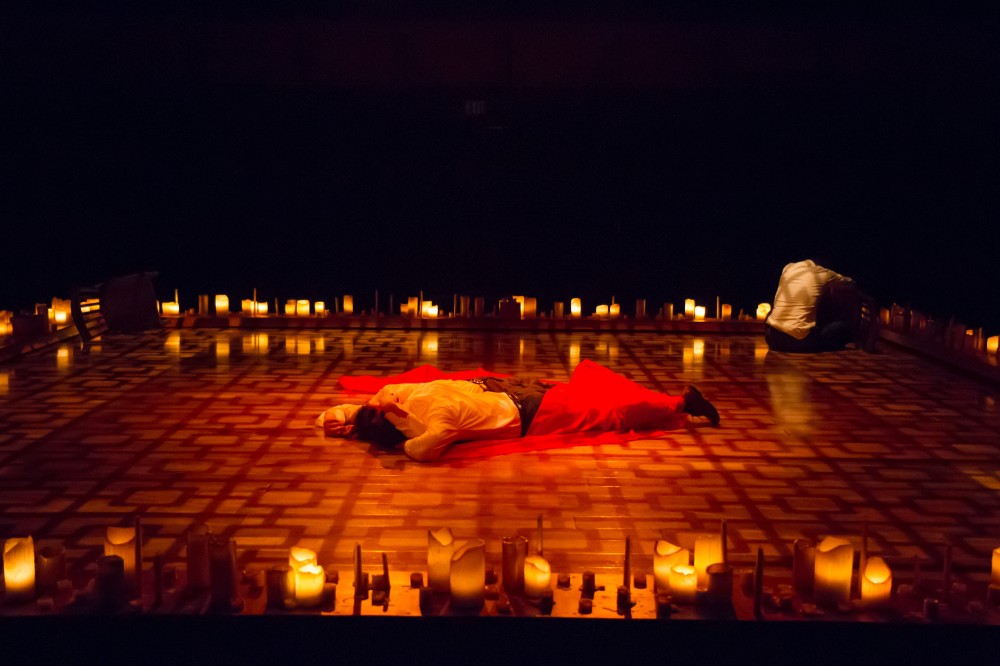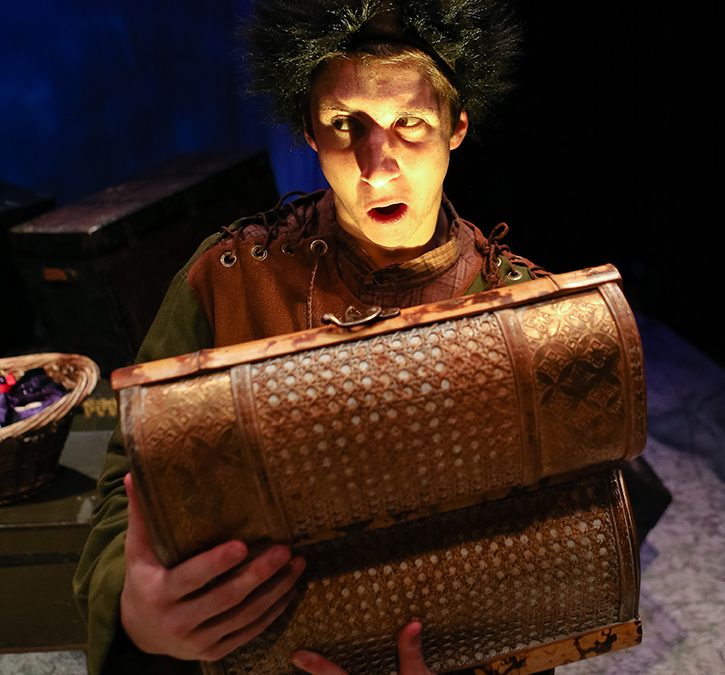
Cirque Du Soleil – KURIOS – Cabinet des Curiosités
AS PRINTED IN AUGUST 2014 STAGE DIRECTIONS MAGAZINE; Written by Eric Hart.
http://www.stage-directions.com/115-all/6274-cabinet-of-wonders.html
Cirque du Soleil is known for its visual spectacle and technical innovation. Their newest tent show, KURIOS – Cabinet des Curiosités, is no exception. They describe the show as following “an ambitious inventor who defies the laws of time, space and dimension in order to reinvent everything around him.” But the Cirque artist tasked with actually inventing the props and gags to bring the show magic to life was Marc André Roy, the lighting project manager on Kurios.
Although this is only Roy’s second show with Cirque du Soleil as a project manager, he has been with the company for 12 years, mainly as head of lighting, so he knows a lot about all the shows and how the company likes to work. Although the aesthetic for Kurios is different from previous Cirque productions, the process remained the same. Two years before the show opens, the designers and creators begin working on ideas. After six months, the project management team comes in and tells them what is actually possible. For Roy and the other people in production roles, this starts a busy 15-month period. “First we have to get familiar with what the show is supposed to be and what is desired, and after that, to try to make it happen as much as possible, respecting all the designers’ wishes.”
For this show, the designers came in already wanting to incorporate equipment from RC4 Wireless. “It met their needs and matched the aesthetic they wanted to give to the show.”
And the needs were considerable. Roy and his team had to “fit as much equipment—fixtures, controllers and battery packs—into the smallest, smallest space given to us,” Roy explains. In one scene, a juggler balances a giant Edison “lightbulb” on his head. It’s a simple-looking gag, but making it a reality meant a lot of engineering. Roy and his team began by completely deconstructing the artist’s equipment, and then figuring out how to integrate the necessary components before rebuilding everything. The light source is a simple LED fixture with a lithium polymer (LiPo) battery and DMX dimmer inside the lightbulb. Roy and his team tested different configurations and prototypes until they got the technical result they wanted—while making sure the artist remained comfortable and confident with what they used. And they had to do this for a multitude of items in the show. Adding even a small amount of weight to a prop an artist needs to juggle or manipulate with precision can affect their balance and timing. In this they were aided by the miniscule size of RC4’s equipment, which was really important for Cirque—no matter the size of the piece, whether it was the lightbulb for the juggler or a gigantic Russian cradle for acrobats. The cradle for Kurios has six 50W LED floodlights and two strings of festoon lights, all controlled wirelessly with just one of RC4 Wireless’ DMXio receivers.
Roy and his team were able to introduce a lot of LED fixtures to Kurios, now that LEDs perform better and are more available than they were in the past. It also helps that RC4 dimmers have handled LEDs with ease for almost a decade, using a custom dimming curve developed by James David Smith, founder of RC4 Wireless, that dims LEDs as smoothly as incandescents.
In addition to lighting, the wireless dimmers control a lot of little DC motors and relay switches. “We are now seriously introducing the wireless control to the automation system,” Roy says, though he emphasizes that RC4 Wireless is used only for basic automation; anything involving human safety is a different system.
Getting Involved
Sometimes, though, the designers’ imaginations go beyond what the technology is capable of. When that happens, Roy is happy to have Smith on speed dial.
“They sometimes arrive with a basic plan, and a slightly off-center idea of how they’re going to accomplish it,” Smith says with a slight smile. “Often they hope to use a regular RC4 product in a way that will not quite work.” That’s when Smith has to modify one of his existing products, or create a new one from scratch.
Working on Kurios led to one such new product. In one scene, five remote-controlled dollies run around on stage. They were using tiny 24V DC motors to run them, but nothing existed on the market that could control them. So they turned to James, who made a 24-volt wireless controller and had it in their hands within a week. Unfortunately, the power draw was too high and the boards began overheating. “These little things, they’re often something completely new, and you don’t know what’s going to happen until they actually run them.”
Smith added a fan to cool the boards down, and thanks to the magic of FedEx everything was fixed within 48 hours after discovering the problem. “We only missed two days of staging with those elements,” says Roy. “They’re still in action now and performing very well.”
Smith is not surprised they are still working. “Tech rehearsals in general push everything a lot harder than actually running the show,” he says. For a really difficult scene with batteries and controllers, the same cue will be run over and over again until it is right. If a piece is going to fail, it is going to fail then, rather than during the run.
Solutions like the 24-volt motor controller become new products RC4 Wireless can offer to other customers. “In the last several years, I would say every new product that I’ve come out with originated as an actual need by somebody.”
Wireless Storms
In addition to their small size, the flexibility of the dimmers, and the speed with which new RC4 products can be created, Roy shares another important reason they use them: rock-solid radio. “Our venue is quite sensitive to radio waves and frequencies in general,” he says. “Basically, the big top in which we perform is a gigantic tent that will let just about anything but the rain come in.”
That tent is located in a part of Montreal known as The Old Port, (before going on a worldwide tour for the next 10 years); it is still an active port, filled with the radio waves from navigation and water traffic. The city also broadcasts WiFi at a high level to all the tourists in the area. Cirque uses a lot of wireless in their own infrastructure; the offices are wireless, and the box office and merchandising use wireless credit card machines. In the house is Clear-Com and wireless mics, and every night, 2,500 audience members show up with their smart phones. The amount of radio waves flying through Cirque’s tent is quite the challenge for Roy: “Each time we decide to go wireless, it’s a horrible, horrible headache.”
But the RC4 system gives his team the flexibility to either identify a specific position in the wireless spectrum each piece of equipment should operate in, or to just let the equipment scan the frequencies and find where it is safest to be. Each piece of RC4 equipment for each show is given a unique digital identification code, so it will never get confused by other equipment in its vicinity. “Even though basically the full RF spectrum is heavily, heavily used, we still manage to keep control over all of our equipment,” says Roy.
RC4 products are compliant with various regulations and have obtained the necessary certifications for the main markets Cirque operates in, such as Canada, the US, Europe, Australia and Japan. Many other manufacturers have only pending authorizations; for a company like Cirque du Soleil, details like that make a huge difference.
As for control of the wireless dimmers, Marc André explains, “We’re using 10 DMXio transceivers on this show. One is assigned as the main transmitter connected to the lighting desk, and all others are located at different areas, where they will be controlling a group of lights.” They also use the transceivers to control independent dimmers on top of the two 96 dimmer racks that they tour with.
Everything is programmed and controlled from one lighting desk in the main control booth (an MA Lighting grandMA2 console). Out of the 14 universes used in the show, two are dedicated to the different wireless equipment; one controls all the remote control lights, fixtures and motors. The second one is dedicated to one acrobatic act that, for safety reasons, is operated separately by the head rigger from a different, smaller console.
While it’s great that the RC4 transceivers tie in nicely with the console, their flexibility with control was nice, too. During creation, Cirque’s facilities have all of the elements and different parts of the show spread out in different rooms and Roy often needed to work on RC4’s wireless elements in different rooms with different artists.
“We’re lucky we have enough space to basically install an entire big top inside our studios, so all the elements that the audience can see tonight, inside the tent, was at some point completely installed inside our studio here. People will come in, dressed up in their brand-new costumes, and everybody—the artists, the crew, the cast, everybody—gets to see it as it all happens. It’s really stimulating,” explains Roy. To help him out they would move the main transceiver from the lighting console to his computer for control, using RC4’s PC Control Software.
“We would just move with a laptop and go from room to room to work on one act or with one artist specifically,” he adds. “That flexibility was quite appreciated.” Since it meant that, in Roy’s words, “We can do just about whatever we want with them.” Which is something prop makers and lighting crews for any theatre company can appreciate.
RC4 Inventory in Kurios
13 DMX2dim – 2 channel dimmer
3 DMX4dim – 4 channel dimmer
7 DMX2micro – mini 2 channel dimmer
1 RC4MagicPC-USB1 – connects PC to RC4 system
1 DMXioR3 – data transceiver
9 DMXioR3-HG – data transceiver with external antenna
5 DMXmot24 – 24V motion controllers
1 DMX4dim-500 – High Power 4 channel dimmer
[pexyoutube pex_attr_src=”https://www.youtube.com/watch?v=HmnJBc0M1lY”][/pexyoutube]
[pexyoutube pex_attr_src=”https://www.youtube.com/watch?v=Rk-N93tAPrQ”][/pexyoutube]



